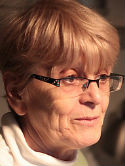Targeting Bcl-2 family members with the BH3 mimetic AT-101 markedly enhances the therapeutic effects of chemotherapeutic agents in in vitro and in vivo models of B-cell lymphoma Journal Article
| Authors: | Paoluzzi, L.; Gonen, M.; Gardner, J. R.; Mastrella, J.; Yang, D.; Holmlund, J.; Sorensen, M.; Leopold, L.; Manova, K.; Marcucci, G.; Heaney, M. L.; O'Connor, O. A. |
| Article Title: | Targeting Bcl-2 family members with the BH3 mimetic AT-101 markedly enhances the therapeutic effects of chemotherapeutic agents in in vitro and in vivo models of B-cell lymphoma |
| Abstract: | Overexpression of antiapoptotic members of the Bcl-2 family are observed in approximately 80% of B-cell lymphomas, contributing to intrinsic and acquired drug resistance. Nullifying antiapoptotic function can potentially overcome this intrinsic and acquired drug resistance. AT-101 is a BH3 mimetic known to be a potent inhibitor of antiapoptotic Bcl-2 family members including Bcl-2, Bcl-XL. and Mcl-1. In vitro, AT-101 exhibits concentration- and time-dependent cytotoxicity against lymphoma and multiple myeloma cell lines, enhancing the activity of cytotoxic agents. The IC50 for AT-101 is between 1 and 10 μM for a diverse panel of B-cell lymphomas. AT-101 was synergistic with carfilzomib (C), etoposide (E), doxorubicin (D), and 4-hydroxycyclophosphamide (4-HC) in mantle cell lymphoma (MCL) lines. In a transformed large B-cell lymphoma line (RL), AT-101 was synergistic when sequentially combined with 4-HC, but not when both drugs were added simultaneously. AT-101 also induced potent mitochondrial membrane depolarization (Δψm) and apoptosis when combined with carfilzomib, but not with bortezomib in MCL. In severe combined immunodeficient (SCID) beige mouse models of drug-resistant B-cell lymphoma, 35 mg/kg per day of AT-101 was safe and efficacious. The addition of AT-101 to cyclophosphamide (Cy) and rituximab (R) in a schedule-dependent manner enhanced the efficacy of the conventional therapy. © 2008 by The American Society of Hematology. |
| Keywords: | cancer chemotherapy; controlled study; treatment response; unclassified drug; doxorubicin; drug dose comparison; drug efficacy; drug potentiation; drug safety; nonhuman; drug targeting; rituximab; drug megadose; flow cytometry; antineoplastic agent; mass spectrometry; animal cell; mouse; animal; animals; mice; protein bcl 2; apoptosis; bortezomib; mantle cell lymphoma; multiple cycle treatment; multiple myeloma; confocal microscopy; microscopy, confocal; etoposide; antineoplastic combined chemotherapy protocols; animal experiment; animal model; mitochondrial membrane potential; antineoplastic agents, phytogenic; cyclophosphamide; antineoplastic activity; in vitro study; drug effect; drug screening; xenograft model antitumor assays; cell line, tumor; monoclonal antibody; disease model; b cell lymphoma; blotting, western; lymphoma, b-cell; antibodies, monoclonal; add on therapy; lymphoma cell; tumor cell line; western blotting; drug derivative; single drug dose; large cell lymphoma; drug blood level; high performance liquid chromatography; drug cytotoxicity; disease models, animal; drug dose increase; biomimetics; bh3 interacting domain death agonist protein; proto-oncogene proteins c-bcl-2; membrane potential, mitochondrial; scid mouse; isosorbide; carfilzomib; protein bid; dose time effect relation; bh3 protein; 4 hydroxycyclophosphamide; gossypol derivative; gossypol; gossypol acetic acid |
| Journal Title: | Blood |
| Volume: | 111 |
| Issue: | 11 |
| ISSN: | 0006-4971 |
| Publisher: | American Society of Hematology |
| Date Published: | 2008-06-01 |
| Start Page: | 5350 |
| End Page: | 5358 |
| Language: | English |
| DOI: | 10.1182/blood-2007-12-129833 |
| PUBMED: | 18292288 |
| PROVIDER: | scopus |
| DOI/URL: | |
| Notes: | --- - "Cited By (since 1996): 50" - "Export Date: 17 November 2011" - "CODEN: BLOOA" - "Source: Scopus" |
Altmetric
Citation Impact
BMJ Impact Analytics
MSK Authors
-
 94
94Heaney -
 1041
1041Gonen -
 161
161Manova-Todorova -
 34
34Gardner
Related MSK Work


